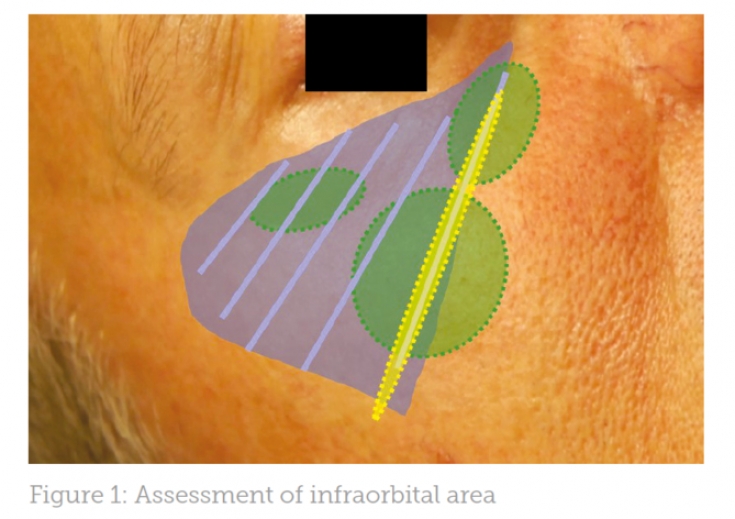Because the skin in the infraorbital zone is very thin, any damage to the structure in this zone is immediately noticeable – age and fatigue are reflected under the eyes like no other area of the face. One of the most popular non-surgical methods for correcting the infraorbital zone – HA injections, which can reduce the depth of the nasolacrimal trough and refresh the patient's appearance.
It is difficult to work with this area, because overcorrection or incorrect injection of the HA filler is immediately evident. Therefore, Dr. Tom van Eyck developed a protocol called Palma Technique, in which the correction of the infraorbital sulcus is performed by influencing both the skin and underlying tissues.
High-risk area: difficulties in correction of the infraorbital sulcus
Lower eyelid area – one of the most anatomically complex areas of the face. Its structures are prone to the appearance of signs of aging due to mechanical vulnerability. With age, the soft tissues of the infraorbital region lose their volume, and the quality of the skin decreases.
Follow us on Instagram!
When correcting the infraorbital zone, special care must be taken, since several arteries pass through it, which are connected to the vessels that provide blood flow to the optic nerve.
Vision loss has been reported following HA injections due to occlusion of the ophthalmic artery, although this complication is more common with nose bridge or brow bridge correction.
There are known cases of loss of vision after HA injections as a result of occlusion of the ophthalmic artery, although this complication is more common with correction of the bridge of the nose or between the eyebrows.
Also, a serious problem for the patient can be the appearance of hematomas, which are almost impossible to hide with makeup. Therefore, at the consultation stage, it is important to warn the patient about this complication.
Nasal tear trough correction: do without surgery
Palma Technique Protocol for Infraorbital Zone Correction
The assessment of the state of the infraorbital zone is carried out as follows:
• strength and thickness of leather – by pinching it between the thumb and forefinger;
• lack of volume – visually;
• infraorbital sulcus depth – through palpation.
An example is shown in Fig. 1: insufficiently firm skin (purple zone), lack of volume in areas marked in green. The level of attachment of the zygomatic ligament to the skin is marked in yellow.

Fig. 1: assessment of the state of the infraorbital zone
The author recommends using a 1 ml syringe for the procedure. At the same time, only 0.2 ml of HA (0.1 ml for each eyelid) may be enough to improve the condition of the lower skin, and 0.8 ml – for the correction of subdermal volumes in both infraorbital zones.
The author recommends starting the procedure with strengthening the skin structure. To do this, a small amount of filler is injected into the middle layer of the dermis, starting laterally from the lower eyelid and ending at the level of the zygomatic skin ligament, where the cheek skin is thicker. Often, the skin located laterally in relation to the cheek is distinguished by its thinness and becomes even thinner with age. That is why it is so important to increase its thickness.
How to make the correction of the nasolacrimal trough as effective as possible
Next step – replenishment of adipose tissue volumes in the lower eyelid area: the drug is injected into the infraorbital groove. Preliminary, aspiration and checking of the tissue area into which the needle will be inserted is carried out. So the specialist minimizes the risk of introducing a filler into the vessel. To check the uniformity of the fabric, a slight movement of the needle tip from side to side is sufficient. A cannula can also be used for deeper volumization.
The author recommends using a 1 ml syringe for the procedure. At the same time, only 0.2 ml of HA (0.1 ml for each eyelid) may be enough to improve the condition of the lower skin, and 0.8 ml – for correction of subdermal volumes in both infraorbital zones.
This zone is characterized by the presence of excess skin, as well as protrusion of the infraorbital fat compartments that are in the orbit of the eye. Fillers are not used to correct such indications, as they cannot reduce the amount of skin or adipose tissue.
Course of procedures and results of application of the Palma technique
The effect of strengthening the dermis in the infraorbital zone appears a few months after the first procedure. Therefore, repeated administration of the drug in order to enhance this effect should be considered after the specified time period. In some cases, if the skin in the target area is excessively weakened, a third procedure may be necessary (usually in patients over 40 years of age).
After obtaining optimal results after 1-2 years, it may be necessary to re-correct the infraorbital zone.
Results
An increase in subdermal volumes is observed immediately after HA administration. As a result of injection, hematomas and swelling may appear,
Nasal trough contouring: professional advice
The advantage of the Palma technique is to increase the thickness of the skin. Thanks to this, it is possible to obtain better correction results than exclusively with the replenishment of soft tissue volumes.
Adapted from Aesthetics







Add a comment